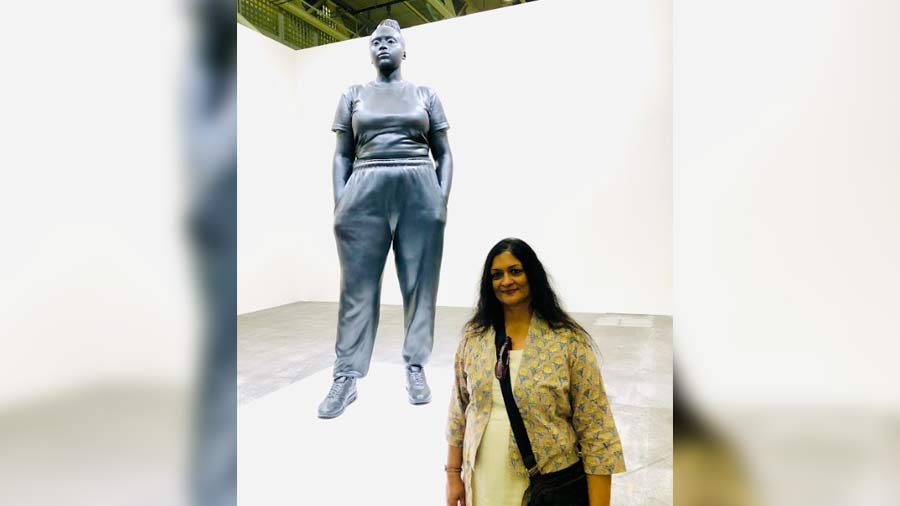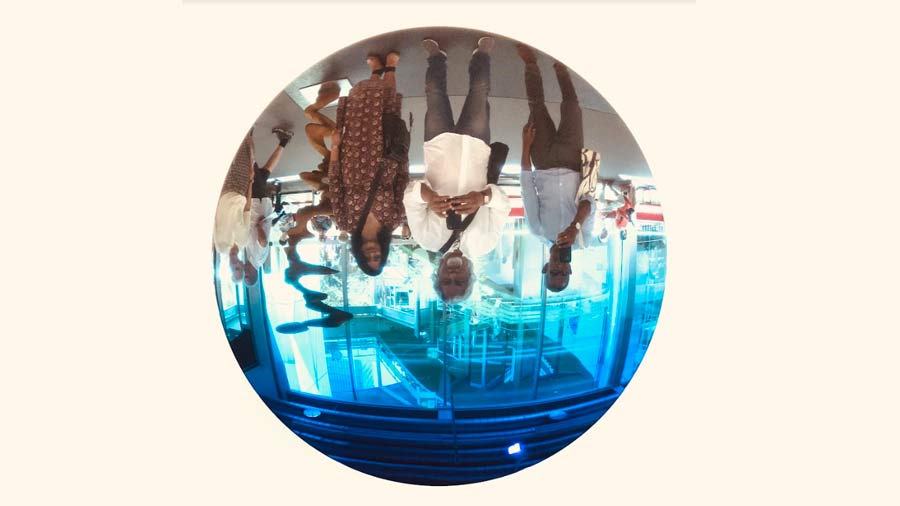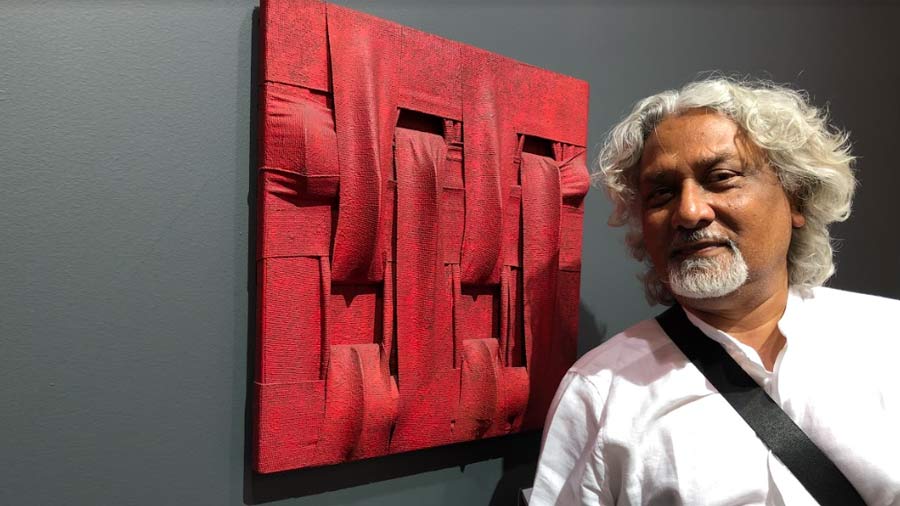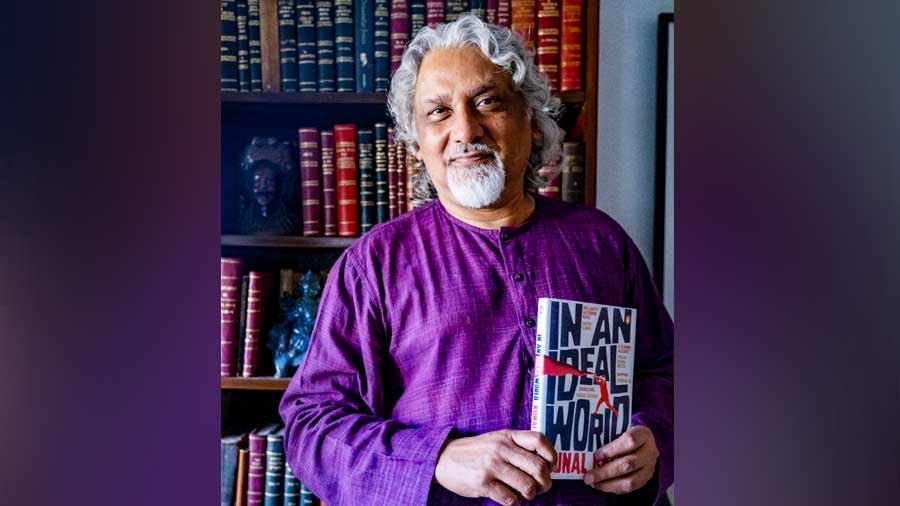“Business or pleasure?” The French immigration officer asked what was the reason for our visit at the busy entry counter of EuroAirport that services Basel in Switzerland, Germany’s Freiburg and Mulhouse of France.
“Passion,” I replied, inviting an arched eyebrow. Her face broke into a smile when I mentioned Art Basel. “Ah! and how long will you stay?” she asked, frowning at the answer, “Just 3 days! C’est trop court” — That’s too short! Stamping our passports, she advised us to stay longer, presumably, to give full vent to our passion. It was the only time that I could recall when I’d been advised at immigration to stay longer than planned.
It is the undisputed ‘must’, the place to show, see and be seen

Kunal with his wife Susmita Basu at the event
But then, what Cannes is to the film world and Frankfurter Buchmesse is to publishing, Art Basel is to art lovers: the greatest show on earth. Frozen out for two years on account of the pandemic, the show had returned this year with a vengeance, flaunting 200 leading galleries and more than 4,000 artists from five continents.
Started in 1970, it is the world’s premier event attracting dealers, collectors, art advisers, curators, museum directors, PR professionals, journalists and, of course, artists. In the crowded yearly calendar of art fairs, it is the undisputed “must”, the place to show, see and be seen.
At one gulp a Blue Period Picasso rubbing shoulders with a pair of Doc Marten boots
It is easy, we found out, to visit the fair, unfettered by long queues and helped along by chirpy volunteers, provided one forked out the rather hefty CHF 60 (just under Rs 5,000) for a day pass. The stiff ask was meant to reduce footfall — a Swiss friend explained — and make it a pleasant experience for the Ultra High Net Worth visitors. Once inside, it takes a few gasping moments to comprehend the gigantic scheme of things, the sheer volume of art and the stream of visitors navigating the galleries like rats in a maze. Without a master curator orchestrating the flow, visitors might find the experience to be unnervingly similar to browsing in a giant-sized mall with scrambled merchandise, each section potentially distracting to the other. One is likely to take in at one gulp a Blue Period Picasso rubbing shoulders with a pair of Doc Marten boots touted as high art by some adrenaline-charged gallerist.

Susmita Basu at the Unlimited pavilion
“Do you have people walking by and buying a Picasso off the wall just like that?” I asked a suave young man fronting for a Madison Avenue gallery. “Sure,” he nodded, “or a Matisse, a Jackson Pollock or a Kandinsky, that we have on display here.” And do they haggle over the price? I was tempted to ask. Would he accept cash for the millions? “Given the astronomical fare, there must be a lot of crooks among the buyers, I presume?” I teased him. The man grinned, “Not all of them are, I hope!”
A virtuous circle, profitable to both superstar dealers and top collectors
Strolling among the galleries reminded me of a wonderful account of the contemporary art world written by Don Thompson. Fairs such as Basel feature superstar dealers drawn by the presence of top collectors, who, in turn, are lured by the presence of these dealers. It is a virtuous circle, profitable to both. The super-rich are time-poor, and here they have the facility of one-stop shopping. Plus, the presence of fellow collectors adds oomph to the buying game, encouraging feisty bidding and herding behaviour.

With Giacometti and Picasso
A particularly hilarious account in Thompson’s book is that of a bidding war fought in the first 10 minutes of the opening night of Art Basel in 2006. It involved an installation by the artist Terence Koh of glass boxes containing bronze casts of human excrement, covered in 24-carat gold. The dealer had talked it up as a supreme example of contemporary consumerism and accepted a winning bid of $68K.
If you have wondered who wears the outrageous fashion paraded on catwalks, you’ll find them here, the fair doubling as a creative fusion of art, fashion and parties, featuring the likes of Roger Federer — a local boy — no less. Keeping, perhaps, with European decorum, it is, of course, no match to its American franchise — Art Basel Miami Beach — known for intimate and exclusive parties offering bathtubs full of champagne.
Indian galleries: just four out of almost 500!
My part-parochial eye scanned for Indian galleries among the main halls and the satellite events, such as Unlimited (a gigantic space devoted to installations), Liste (a smaller venue for budding gallerists) and Volta (affordable art from emerging artists). The catalogue featured just four — Delhi’s Vadera, Mumbai’s Chemould, and Kolkata’s Experimenter; Volta featured Ahmedabad’s Iram, with an exclusive show of Bengal’s Narayan Sinha’s sculptures. Just four out of almost 500! Where were the contemporary luminaries, let alone the old masters? In my mind’s eye, I saw the likes of Jogen Chowdhury slowing traffic in the hall, even some of the winning entries of the CIMA art prize that I had the privilege to adjudicate upon over the past few years. But barring a sprinkling of Chinese, the ensemble was almost entirely Euro-American.
“It doesn’t make financial or reputational sense to take our collection to these art fairs,” a Kolkata gallerist friend told me afterwards. “The rules for export of art from India are cumbersome, and with expensive insurance on top of that, it makes scant business sense, especially since sales aren’t guaranteed.” Conservative estimates put the cost of a gallery’s presence in Art Basel — including renting a smallish booth, shipping, insurance, travel and accommodations — at around €40,000 (upwards of Rs 30 lakh).

With an Anish Kapoor work
As much as it is eye-opening, the experience is mind-numbing as well
One is guaranteed tired legs after a day at Art Basel. As much as it is eye-opening, the experience is mind-numbing as well; the intersection of high art and high finance exhilarating yet troubling. Do featured artists find it as absorbing as the gatekeepers, suffer and rejoice as much as the gallerists? Or is the greatest show no more than a ‘show’, that overshadows its very essence?
On the way back to our rented cottage in the charming French village of Saint-Louis one evening, we got chatting with our taxi driver, a refugee from Kurdistan. He loved Indian film music, and hummed a few tunes to regale us. He didn’t know much about the fair, but was happy for us to have visited his adopted city, whatever the reason. Somehow, it helped to complete the circle, connecting art with life.
Kunal Basu is an author of fiction. He lives in Oxford and in Kolkata.



